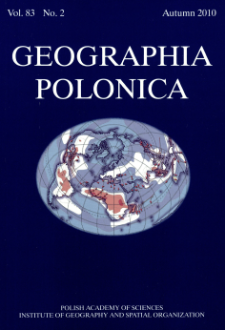
Obiekt
Tytuł: The Hotspot—a new technology, but is it also a new, geographical face of the Internet?
Inny tytuł:
Geographia Polonica Vol. 83 No. 2 (2010)
Wydawca:
Miejsce wydania:
Opis:
Typ obiektu:
Bibliografia:
1. Ballon, P. (2007), Changing business models for Europe's mobile telecommunications industry: The impact of alternative wireless technologies, Telematics and Infomatics, 24: 192–205.
http://dx.doi.org/10.1016/j.tele.2007.01.007 -
2. Fuentes–Bautista, M. and Inagaki, N. (2006), Reconfiguring public Internet access in Austin, TX: Wi–Fi's promise and broadband divides, Government Information Quarterly, 23: 404–434.
http://dx.doi.org/10.1016/j.giq.2006.07.013 -
3. Gibson, W. (1989), Mona Lisa Overdrive, New York, Bantam Books.
4. Gorman, S.P. and McIntee, A. (2003), Tethered connectivity? The spatial distribution of wireless infrastructure, Environment and Planning A, 35: 1157–1171.
http://dx.doi.org/10.1068/a35255 -
5. Grubesic, T.H. and Murray, A.T. (2004), "Where" matters: location and Wi–Fi access, Journal of Urban Technology, 11: 1–28.
http://dx.doi.org/10.1080/1063073042000341952 -
6. Ilnicki, D. (2002), Fenomen kawiarenek internetowych [The phenomenon of Internet cafes], in: Współczesne formy osadnictwa miejskiego i ich przemiany, XV Konwersatorium Wiedzy o Mieście [The current forms of urban settlement and their transformations, 15th Seminar on knowledge about a city], Łódź, Poland, 249–262.
7. Ilnicki, D. and Janc K. (2008), Węzłowość i przestrzeń przepływów Internetu: ujęcie globalne i lokalne [Nodality and space of Internet flows: the global and the local scale], Geopolis—Elektroniczne Czasopismo Geograficzne, 1: 5–23.
8. Johnston, J.H. Snider, J.H. (2003), Breaking the chains: unlicensed spectrum as a last–mile broadband solution, New America Foundation, Spectrum Series Working Paper, no.7.
9. Kitchin, R.M. (1998), Towards geographies of cyberspace, Progress in Human Geography, 22: 385–406.
http://dx.doi.org/10.1191/030913298668331585 -
10. Kwan, M. (2006), Transport geography in the age of mobile communications, Journal of Transport Geography, 14: 384–385.
http://dx.doi.org/10.1016/j.jtrangeo.2006.06.002 -
11. Mapping the existing European wireless landscape and current trends. Annex 1. (2005), Institute for Prospective Technological Studies, European Communities, (www.jrc.es).
12. Powell, A. (2009), Wi–Fi as public utility or public park? Metaphors for planning local communications infrastructure, available at <http://ssrn.com/abstract=1330913)>.
13. Sandvig, Ch. (2004), An initial assessment of cooperative action in Wi–Fi networking, Telecommunications Policy, 28: 579–602.
http://dx.doi.org/10.1016/j.telpol.2004.05.006 -
14. Shamp, S.A. (2004). Wi–Fi clouds and zones: a survey of municipal wireless initiatives, New Media Institute, University of Georgia.
15. Torrens, P.M. (2008), Wi–Fi geographies, Annals of the Association of American Geographers, 98: 59–84.
http://dx.doi.org/10.1080/00045600701734133 -
Czasopismo/Seria/cykl:
Tom:
Zeszyt:
Strona pocz.:
Strona końc.:
Szczegółowy typ zasobu:
Format:
Rozmiar pliku 5,1 MB ; application/pdf
Identyfikator zasobu:
10.7163/GPol.2010.2.4 ; oai:rcin.org.pl:1936
Źródło:
CBGiOS. IGiPZ PAN, sygn.: Cz.2085, Cz.2173, Cz.2406 ; kliknij tutaj, żeby przejść
Język:
Prawa:
Prawa zastrzeżone - dostęp nieograniczony
Zasady wykorzystania:
Digitalizacja:
Instytut Geografii i Przestrzennego Zagospodarowania Polskiej Akademii Nauk
Lokalizacja oryginału:
Dofinansowane ze środków:
Program Operacyjny Innowacyjna Gospodarka, lata 2010-2014, Priorytet 2. Infrastruktura strefy B + R ; Unia Europejska. Europejski Fundusz Rozwoju Regionalnego
Dostęp:
Kolekcje, do których przypisany jest obiekt:
- Repozytorium Cyfrowe Instytutów Naukowych > Kolekcje Partnerów > Instytut Geografii i Przestrzennego Zagospodarowania PAN > Publikacje pracowników i Wydawnictw
- Repozytorium Cyfrowe Instytutów Naukowych > Kolekcje Partnerów > Instytut Geografii i Przestrzennego Zagospodarowania PAN > Biblioteka Instytutu > Serie/Czasopisma/Cykle
- Repozytorium Cyfrowe Instytutów Naukowych > Piśmiennictwo > Czasopisma/Artykuły
Data ostatniej modyfikacji:
2 paź 2020
Data dodania obiektu:
24 sty 2012
Liczba pobrań / odtworzeń:
2297
Wszystkie dostępne wersje tego obiektu:
https://rcin.org.pl./publication/14089
Wyświetl opis w formacie RDF:
Wyświetl opis w formacie RDFa:
Wyświetl opis w formacie OAI-PMH:
| Nazwa wydania | Data |
|---|---|
| Janc K., Ilnicki D. - The Hotspot—a new technology, but is it also a new, geographical face of the Internet? | 2 paź 2020 |
Obiekty Podobne
Janc, Krzysztof
Ilnicki, Dariusz Janc, Krzysztof
Floriańczyk, Zbigniew Janc, Krzysztof Czapiewski, Konrad
Janc, Krzysztof
Janc, Krzysztof
Janc, Krzysztof
Janc, Krzysztof Siłka, Piotr
Mazur, Marcin (1982– ) Czapiewski, Konrad Ł Janc, Krzysztof Konopski, Michał

 INSTYTUT ARCHEOLOGII I ETNOLOGII POLSKIEJ AKADEMII NAUK
INSTYTUT ARCHEOLOGII I ETNOLOGII POLSKIEJ AKADEMII NAUK
 INSTYTUT BADAŃ LITERACKICH POLSKIEJ AKADEMII NAUK
INSTYTUT BADAŃ LITERACKICH POLSKIEJ AKADEMII NAUK
 INSTYTUT BADAWCZY LEŚNICTWA
INSTYTUT BADAWCZY LEŚNICTWA
 INSTYTUT BIOLOGII DOŚWIADCZALNEJ IM. MARCELEGO NENCKIEGO POLSKIEJ AKADEMII NAUK
INSTYTUT BIOLOGII DOŚWIADCZALNEJ IM. MARCELEGO NENCKIEGO POLSKIEJ AKADEMII NAUK
 INSTYTUT BIOLOGII SSAKÓW POLSKIEJ AKADEMII NAUK
INSTYTUT BIOLOGII SSAKÓW POLSKIEJ AKADEMII NAUK
 INSTYTUT CHEMII FIZYCZNEJ PAN
INSTYTUT CHEMII FIZYCZNEJ PAN
 INSTYTUT CHEMII ORGANICZNEJ PAN
INSTYTUT CHEMII ORGANICZNEJ PAN
 INSTYTUT FILOZOFII I SOCJOLOGII PAN
INSTYTUT FILOZOFII I SOCJOLOGII PAN
 INSTYTUT GEOGRAFII I PRZESTRZENNEGO ZAGOSPODAROWANIA PAN
INSTYTUT GEOGRAFII I PRZESTRZENNEGO ZAGOSPODAROWANIA PAN
 INSTYTUT HISTORII im. TADEUSZA MANTEUFFLA POLSKIEJ AKADEMII NAUK
INSTYTUT HISTORII im. TADEUSZA MANTEUFFLA POLSKIEJ AKADEMII NAUK
 INSTYTUT JĘZYKA POLSKIEGO POLSKIEJ AKADEMII NAUK
INSTYTUT JĘZYKA POLSKIEGO POLSKIEJ AKADEMII NAUK
 INSTYTUT MATEMATYCZNY PAN
INSTYTUT MATEMATYCZNY PAN
 INSTYTUT MEDYCYNY DOŚWIADCZALNEJ I KLINICZNEJ IM.MIROSŁAWA MOSSAKOWSKIEGO POLSKIEJ AKADEMII NAUK
INSTYTUT MEDYCYNY DOŚWIADCZALNEJ I KLINICZNEJ IM.MIROSŁAWA MOSSAKOWSKIEGO POLSKIEJ AKADEMII NAUK
 INSTYTUT PODSTAWOWYCH PROBLEMÓW TECHNIKI PAN
INSTYTUT PODSTAWOWYCH PROBLEMÓW TECHNIKI PAN
 INSTYTUT SLAWISTYKI PAN
INSTYTUT SLAWISTYKI PAN
 SIEĆ BADAWCZA ŁUKASIEWICZ - INSTYTUT TECHNOLOGII MATERIAŁÓW ELEKTRONICZNYCH
SIEĆ BADAWCZA ŁUKASIEWICZ - INSTYTUT TECHNOLOGII MATERIAŁÓW ELEKTRONICZNYCH
 MUZEUM I INSTYTUT ZOOLOGII POLSKIEJ AKADEMII NAUK
MUZEUM I INSTYTUT ZOOLOGII POLSKIEJ AKADEMII NAUK
 INSTYTUT BADAŃ SYSTEMOWYCH PAN
INSTYTUT BADAŃ SYSTEMOWYCH PAN
 INSTYTUT BOTANIKI IM. WŁADYSŁAWA SZAFERA POLSKIEJ AKADEMII NAUK
INSTYTUT BOTANIKI IM. WŁADYSŁAWA SZAFERA POLSKIEJ AKADEMII NAUK


































